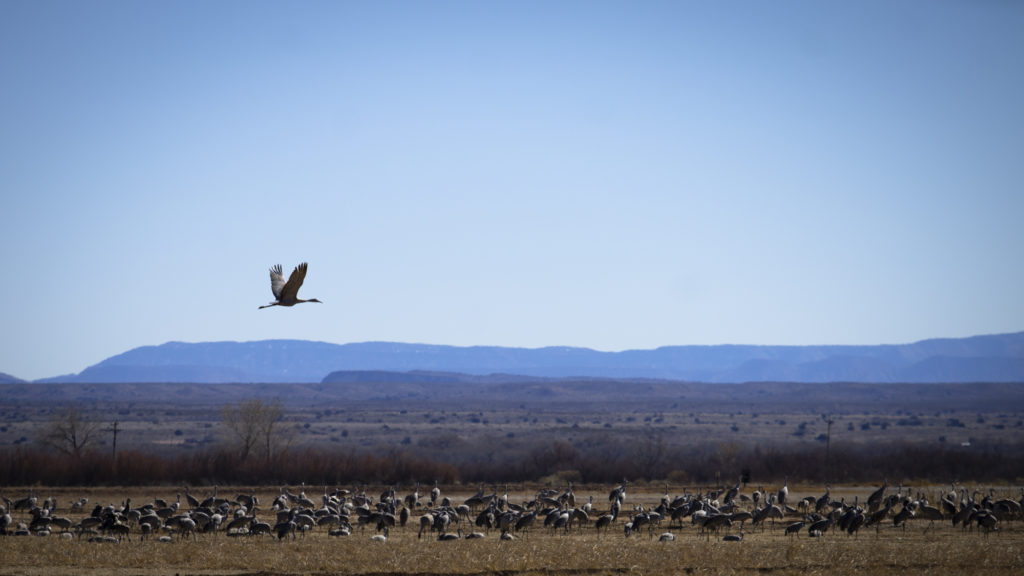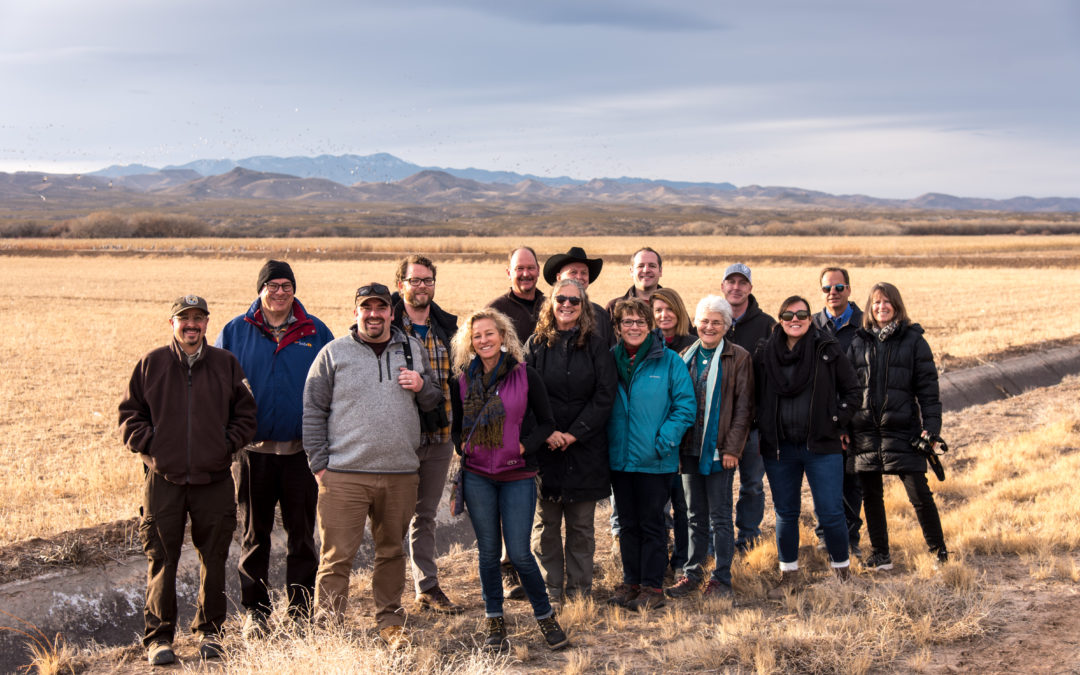On January 29th, Rio Grande Agricultural Land Trust and a few of our conservation partners (Rio Grande Return, Save Our Bosque Task Force, and Friends of Bosque del Apache), led a tour for representatives from the Sunzia Corporation, Pattern Energy, Audubon, and Senators Heinrich’s and Udall’s offices. Since the inception of Sunzia’s Southwest Transmission Project a decade ago, conservation groups and local citizens have been requesting that Sunzia take their proposed 2-500KV transmission lines under the Rio Grande, rather than overhead across the critical middle Rio Grande migratory bird path. We hoped taking them on a tour to see our conservation work and experience the awe of the birds firsthand would demonstrate to them the importance of eliminating the threat posed by 500KV lines crossing the Rio Grande in this sensitive migratory bird corridor.
The tour took place in the Socorro reach of the middle Rio Grande, a critical migratory path and the winterfeeding ground for Rocky Mountain Sandhill cranes and hundreds of other migratory bird species. We were greeted by 10,000 cranes at Bernardo Game Refuge, 10,000 more cranes at Bosque del Apache NWR, and tens of thousands of other migratory birds that winter in the middle Rio Grande. Refuge managers explained the importance of the narrow, bottle-necked middle Rio Grande migratory corridor to the Central Flyway. It is perhaps one of the most critical corridors in the nation, an international migration path from Canada to Mexico.
“I am not going to be here in 50 years”, said Gary Crane, Sunzia representative. This poignant statement made during the tour is exactly the issue of concern. Sunzia’s proposed 500KV transmission lines will be in place for 50 years. They will be disrupting this sensitive migratory corridor used by Sandhill cranes for millions of years. The lines will fragment a fragile migratory bird corridors, impacting decades of conservation work and impacting future conservation efforts.
The Department of Defense’s Technical Working Group Report demonstrates the feasibility and cost analysis of undergrounding 500KV transmission lines, a mere engineering cost change in the scope of a multi-billion dollar project. Given the impacts to birds over the transmission line’s 50 year life span, it seems avian mitigation costs would be much higher the cost of taking the lines under the river. Not to mention, there is no agency named to enforce any the very vague proposed Avian Mitigation Plan.

Photo by Christi Bode
Over the past 80 years, state & federal agencies and conservation organizations have worked collaboratively to protect migratory bird habitat and migration corridors. Through these collaborative conservation efforts, Rocky Mountain Sandhill Crane populations have increased from 400 in the 1940’s to a population of over 20,000 today. This increase is despite numerous ongoing threats such as urbanization, loss of irrigated farmland and riparian wetlands, drought, and transmission lines.
“Growing cranes” is not an easy task. These majestic birds have a lifespan of 35 years. They are socially monogamous, mating for life with both parents caring for the young. They don’t begin breeding until 2 to 8 years old, the upper years are the most viable production years. On average, cranes successfully raise one offspring to a stage of independence every three years. Given this slow growth rate, conservation and management of crane populations is challenging.
RGALT and our conservation partners are not opposed to renewable energy. We are simply requesting that Sunzia’s renewable energy transmission lines be implemented in the most conservation minded way, minimizing ecosystem impacts. For decades, dozens of conservation partners have worked together to protect and restore natural habitat in the middle Rio Grande, a highly sensitive migratory bird corridor, eliminating negative impacts is a necessary component of this effort. Energy sprawl will significantly impact land use and natural resource conservation in the coming decades, doing it right from the onset is critical.
We are speaking out on behalf of the birds. We are their voice.
If you are passionate about protecting New Mexico’s migratory birds, contact your representative and let them know you are against Sunzia river crossing on the Rio Grande flyway.
Questions or comments? Contact Cecilia Rosacker at cecilia@rgalt.org.

